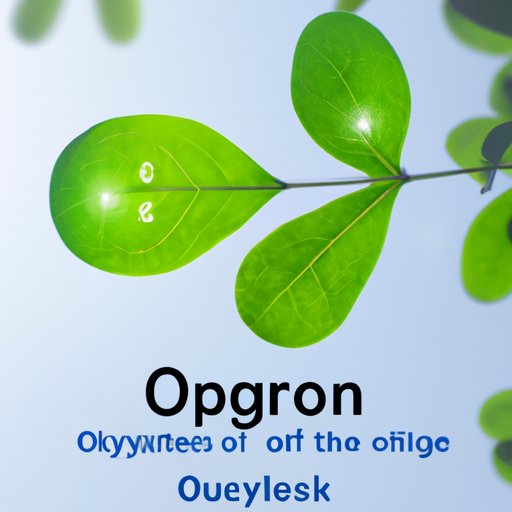I. Introduction
Have you ever wondered how plants are able to produce the oxygen we breathe? Understanding the process of oxygen production in plants is crucial to sustain life on Earth. In this article, we will explore the science behind oxygen production in plants and its significance in the oxygen cycle. We will look at how chloroplasts play a role, the different types of chlorophyll, and the environmental factors that affect the process. Let’s dive into the miracle of photosynthesis and how plants create oxygen.
II. The Miracle of Photosynthesis: How Plants Create Oxygen
Before we delve into the nitty-gritty of oxygen production, let’s define photosynthesis. Photosynthesis is the process by which plants use sunlight, water, and carbon dioxide to produce glucose and oxygen. Oxygen is then released into the atmosphere as a byproduct of this process.
The role of plants in the oxygen cycle cannot be overstated. In fact, plants are responsible for generating 70% of the Earth’s oxygen. Without plants, the oxygen level in the atmosphere would drop, making it difficult for living organisms to survive.
Photosynthesis is essential in sustaining life on Earth. Without photosynthesis, living organisms would not have access to oxygen and food sources, making survival nearly impossible.
III. Breaking Down the Science: The Process of Oxygen Production in Plants
The chemical equation for photosynthesis is:
carbon dioxide + water + sunlight → glucose + oxygen
During photosynthesis, plants use sunlight energy to convert carbon dioxide and water into glucose and oxygen. Carbon dioxide is absorbed through pores on the leaf surface called stomata. Water is taken up through the roots and transported to the leaves through the plant’s vascular system.
The different types of chlorophyll play an essential role in photosynthesis. Chlorophyll a is the most common and absorbs light in the red and blue parts of the electromagnetic spectrum. Chlorophyll b absorbs light in the blue and orange parts of the spectrum.
IV. The Role of Chloroplasts in Generating Oxygen from Sunlight
Chloroplasts are organelles found in plant cells responsible for photosynthesis. Each chloroplast is surrounded by a double membrane and contains an internal system of thylakoid membranes.
The thylakoid membranes contain the photosynthetic pigments, including chlorophyll, that absorb light energy from the sun. This energy is then used to drive the synthesis of ATP, a molecule that stores energy.
V. From Sunlight to Oxygen: A Step-by-Step Guide to Plant Photosynthesis
The process of photosynthesis occurs in two stages: the light-dependent reactions and the light-independent reactions.
The light-dependent reactions occur in the thylakoid membranes and involve the absorption of light by pigments, such as chlorophyll. This light energy is used to split water molecules into oxygen and hydrogen ions, which are then transported to the next stage of photosynthesis.
The light-independent reactions occur in the stroma, a fluid-filled region of the chloroplast. During this stage, carbon dioxide is converted to glucose, a process known as the Calvin cycle. Energy stored in ATP is used to power the conversion of carbon dioxide into glucose, and oxygen is produced as a byproduct.
VI. The Connection Between Oxygen and Plant Health: An Introduction to Photosynthesis
Photosynthesis is vital to the growth and health of plants. It is the means by which plants produce the energy they need to survive and grow. Without photosynthesis, plants would not be able to produce the glucose they need to grow and produce oxygen for the atmosphere.
Oxygen also plays a critical role in plant health. It is used in the process of respiration, which is how plants convert glucose into usable energy. Oxygen helps to break down glucose, releasing energy that can be used by the plant for growth and other activities.
Environmental factors such as temperature, humidity, and light intensity can affect photosynthesis. If these factors are not within optimal ranges, plant growth and photosynthesis can be negatively impacted.
VII. Photosynthesis Demystified: What Happens in a Plant to Produce Oxygen?
There are several misconceptions about photosynthesis that can lead to confusion about the process and its importance. One common myth is that plants only produce oxygen during the day. While it is true that photosynthesis occurs during the day when there is sunlight available, plants also produce oxygen at night. However, the amount of oxygen produced at night is significantly less than during the day.
Another common misconception is that plants absorb carbon dioxide through their leaves. While it is true that stomata on the leaves allow carbon dioxide to enter the plant, most carbon dioxide is actually taken up through the roots and transported to the leaves through the plant’s vascular system.
VIII. Going Green: Understanding Why Plants are Key to Oxygen Generation on Earth
The relationship between plants and oxygen in the environment is critical. Without plants, there would be no oxygen for living organisms to breathe. Unfortunately, many factors, including deforestation, pollution, and climate change, are posing a threat to plant life and oxygen production.
It is essential to protect plant life and support sustainable living practices to ensure the continued production of oxygen on Earth. You can do your part by supporting environmental initiatives and taking steps to reduce your carbon footprint.
IX. Conclusion
Photosynthesis is a miraculous process that allows plants to produce oxygen, which is vital for the survival of living organisms on Earth. Understanding the process and its importance in the oxygen cycle can help us appreciate the beauty and complexity of the natural world around us. Let’s do our part to protect plant life and support the continued production of oxygen on Earth.
Join us in supporting environmental initiatives and reducing our carbon footprint.
(Note: Is this article not meeting your expectations? Do you have knowledge or insights to share? Unlock new opportunities and expand your reach by joining our authors team. Click Registration to join us and share your expertise with our readers.)
